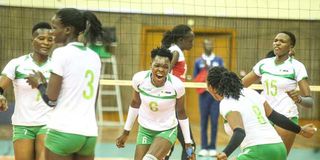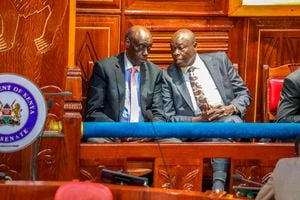New KVF league format could steer Malkia Strikers to VNL if well planned

KCB players celebrate beating rivals Kenya Pipeline during their Kenya Volleyball Federation National League match at Kasarani Indoor Arena on Sunday.
Kenya Volleyball Federation (KVF) National League enters the business end this weekend as the end-of-season play-offs quarter-finals take centre stage at Nyayo National Stadium and Moi International Sports Centre, Kasarani.
For the first time in the history of the competition, eight teams will contest the play-offs as opposed to the traditional four teams as KVF looks to add gloss to the topflight league.
In the new play-off format, the quarter-finals, semis and final will be played in the best-of-three series, meaning clubs must win at least two matches at every knockout stage to proceed to the next round.
This means the earliest the topflight league could be completed is the weekend of June 8-9, assuming that the semifinals will be played next weekend.
While the new play-offs format is a welcome addition to the topflight league, it’s unfortunate that it risks eating into the period usually set aside for national team events as stipulated under the FIVB calendar.
The FIVB calendar requires National Federations to hold their competitions from October to May, after which players join their national teams to prepare for the Volleyball Nations League (VNL), usually held between June and July. In the event of a continental, world championship or Olympic Games year, the national team season could even stretch to August and September, after which players return to their clubs for the new season.
Kenya is yet to qualify for the VNL, but the women’s national team, Malkia Strikers, are within touching distance, especially with the competition having expanded to include 18 teams from 2025 onwards.
National teams
Moving forward, national teams will qualify for VNL through ranking as there will no longer be core and challenger teams from next year. The Volleyball Challenger Cup (VCC), whose winner automatically qualified for the VNL, will also cease to exist.
As of the 2025 edition, the bottom-placed team in VNL’s final standings in each gender will be relegated to be replaced by the respective highest-ranked team in the world for the following VNL season.
No team will be relegated at the end of the VNL 2024 season, while the winners of the 2024 Volleyball Challenger Cup and the highest-placed teams in the FIVB Volleyball World Ranking not yet qualified will join the VNL 2025 action.
Malkia Strikers will be in Manila, Philippines, for the 2024 Women’s Volleyball Challenger Cup (VCC) from July 4 to 7, after which they will proceed to Paris for the Olympic Games scheduled from July 26 to August 11. With the local league set to end on June 8-9, Malkia Strikers will have less than three weeks to train for the VCC, which is a route to the lucrative VNL. This already puts the girls at a disadvantage even before the tournament begins.
Kenya will compete against hosts Philippines, Puerto Rico, and Argentina, among other countries, at this year’s VCC. Winning gold in Manila will certainly be a long shot for Malkia Strikers, given the little time to prepare, which means playing in the VNL next year is almost a pipe dream.
VNL dream
But the VNL dream can certainly be realised with better planning come 2026. For starters, KVF has to ensure that the 2024/2025 starts in early October and find a way to have matches spread over weekends as opposed to the current format of playing one leg in a month. It does not make sporting or commercial sense to have teams stay dormant for a whole month and then play over 20 matches in one weekend. The 2024/2025 regular season should start in October and end in March, after which the end-of-season play-offs will begin.
This will enable the organisers to spread the play-offs over the eight weekends in April and May. A longer period for the play-offs not only allows teams to prepare adequately but also creates commercial opportunities that KVF can cash in to ensure the league champions take a decent cheque home after a season of hard work.
Even more important is that Malkia Strikers will have over three months to prepare for the 2025 World Championship, which could provide a route to the VNL 2026.
Kenya is currently ranked 20th in the FIVB rankings, and a decent outing in next year’s World Championship could earn them enough ranking points to contend for a place in the VNL 2026.
If Malkia Strikers win at least two matches in next year’s World Championship, they could easily replace the relegated team from VNL 2025 as the highest-ranked team not yet qualified and feature in VNL 2026. This will be another historic moment for the record African champions as the first African team to feature in the VNL.
As I drop my pen, I’d like to wish all the teams taking part in the playoffs the best of luck. At stake are valuable slots to next year’s African Club Championship, so give it your best shot!
Samuel Gacharira is a freelance journalist and sports consultant [email protected]





